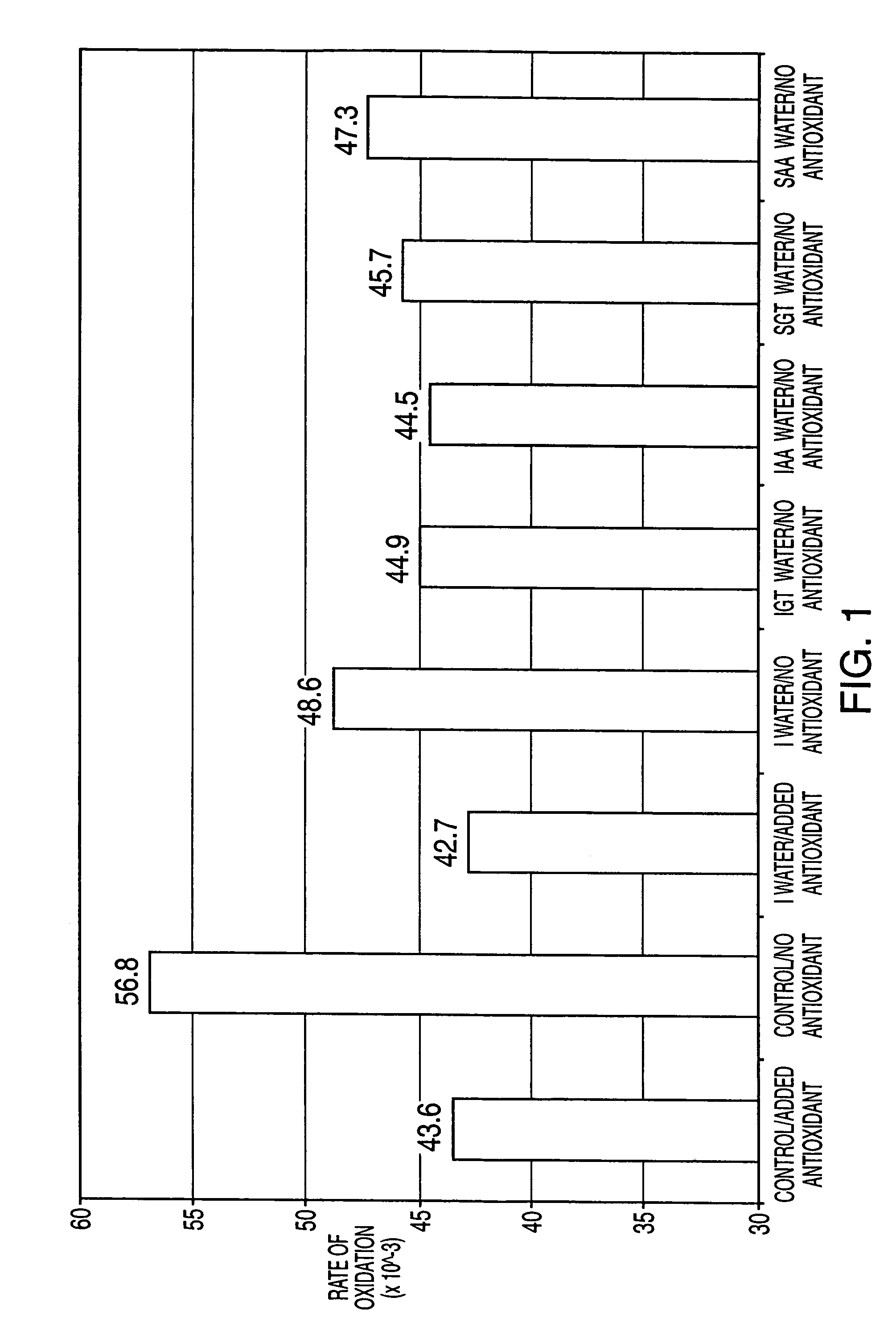Antioxidants in clusters of structured water
a technology of structured water and antioxidants, applied in the field of structured water, can solve the problems of oxidative injury, skin damage, organ damage, etc., and achieve the effect of enhancing the antioxidant activity of structured water
- Summary
- Abstract
- Description
- Claims
- Application Information
AI Technical Summary
Benefits of technology
Problems solved by technology
Method used
Image
Examples
example i
Structured Water with Antioxidant in its Cluster Structure
[0029]The following is an example of the ionic composition of feed water containing an antioxidant for use in making structured water with the antioxidant in its cluster structure.
[0030]
IonAmount (mg / 100 ml)CaCl(2) × 6 H(2)O10.00MgCl(2) × 6 H(2)O3.73Na(2)SO(4)8.80KH(2)PO(4)0.60KNO(3)1.00Green Tea2.00
[0031]Feed water is prepared with the ionic composition described above by adding each ion to the feed water. After ions are added, the green tea is added to the feed water. The resulting feed water has a conductivity of about 340 to 345 μS / cm and a pH of about 5.8 to 6.3. The feed water is fed into the structured water making device at a flow rate of about 200 L / hour. The spaces for gathering and disposing the I water and S water holds a volume of about 220 L. The dipolar molecular structure of the feed water containing green tea is subjected to an electrostatic field having a voltage of about 80 V which causes the water structur...
example ii
[0032]The following formula is an example of a composition containing structured water of the present invention.
[0033]
IngredientPercentStructured Water49.00Methylparaben0.20Butylene glycol4.00Polymeric quaternary ammonium salt12.00Octyl methoxycinnamate8.00Siloxane polymer5.00Wax1.50Cyclomethicone20.20Fragrance0.10
[0034]This example illustrates the antioxidant effect of a lotion containing structured water having antioxidant activity either inherently or by having an antioxidant agent in its cluster structure according to the present invention. The structured water of the formulation can be I water, S water, I water with antioxidant in its cluster, or S water with antioxidant in its cluster. A total of eight samples are prepared according to the formula above to demonstrate the antioxidant effect of the present invention. Four samples, I water prepared with 2 mg / 100 ml green tea extract in its cluster structure (IGT Water / no antioxidant), I water prepared with 2 mg / 100 ml ascorbic a...
example iii
[0038]This example illustrates the effect that electronegative and electropositive clusters of I water and S water have on the inactivation of free radicals. Fluorescence measurements are made in a structured water and lucigenin system, although any other known method of detecting reactive oxygen species can be utilized. The chemilluminiscence of lucigenin (bis-N-methylacridinium nitrate) occurs when it reacts with a reactive oxygen species. Therefore, a lower intensity of the luminiscent emission indicates that free radicals were inactivated by the experimental sample solution and not present to react with lucigenin. The principle of this method is based on the reaction of superoxide ion radicals with lucigenin which produces a fluorescent compound. The intensity of the fluorescent signal is directly proportional to the amount of the superoxide ions present in the solution.
[0039]Three reactive solution mixtures are prepared containing 0.5 ml lucigenin, having a concentration of 0.5...
PUM
| Property | Measurement | Unit |
|---|---|---|
| concentrations | aaaaa | aaaaa |
| concentrations | aaaaa | aaaaa |
| flow rate | aaaaa | aaaaa |
Abstract
Description
Claims
Application Information
 Login to View More
Login to View More - R&D
- Intellectual Property
- Life Sciences
- Materials
- Tech Scout
- Unparalleled Data Quality
- Higher Quality Content
- 60% Fewer Hallucinations
Browse by: Latest US Patents, China's latest patents, Technical Efficacy Thesaurus, Application Domain, Technology Topic, Popular Technical Reports.
© 2025 PatSnap. All rights reserved.Legal|Privacy policy|Modern Slavery Act Transparency Statement|Sitemap|About US| Contact US: help@patsnap.com


